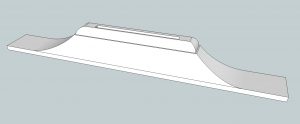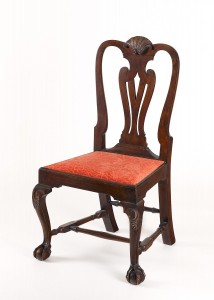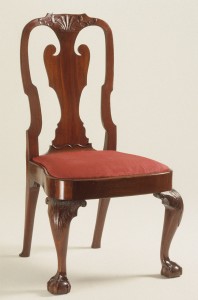We may receive a commission when you use our affiliate links. However, this does not impact our recommendations.
 In my last “Design in Practice” post I talked about how, as furniture transitioned from William & Mary to Queen Anne, the bottom back rail moved down and became the shoe on top of the back seat rail of a chair. It occurred to me that some folks may not know what a shoe is (and I’m not talking about the things you wear on your feet) or that there are a variety of designs.
In my last “Design in Practice” post I talked about how, as furniture transitioned from William & Mary to Queen Anne, the bottom back rail moved down and became the shoe on top of the back seat rail of a chair. It occurred to me that some folks may not know what a shoe is (and I’m not talking about the things you wear on your feet) or that there are a variety of designs.
The shoe is generally a decorative, moulded transition between the back splat (the part of a chair upon which you lean) and the seat. They also have structural value in that they capture the tenon on the bottom of the back splat. This gives the chair back additional strength and rigidity.
Shoes are most often separate pieces from the back rail but, not always. They are usually thicker than the back rail coming flush with the front and back faces of the rear legs. Heights vary depending on design and the design preference of the maker/client. Some are plain while others are carved. I can’t recall seeing any made from woods other than the primary wood of which the chair is constructed, but that doesn’t mean one doesn’t exist somewhere out there.
The whole point of the shoe is to provide a design element that transitions from the rear legs and back seat rail to the back splat. This is most commonly done with some sort of cove that reduces the thickness of the shoe so it can easily be transitioned to the splat.
As a student of 18th century furniture, I find it particularly interesting that most forms of furniture have a wide range of regional variations, but the vast majority of shoes tend to be pretty similar. Sure there are a few anomalies like the cupid’s bow shoe from New York, but the most common form is the same regardless of where it came from or whether the chair is Queen Anne or Chippendale.
The most common form is a cove that is either 1/4 of an ellipse or something closer to 3/8 of one (and sometimes it’s just a half circle). Along the bottom front edge of the shoe is a flat that is usually around 1/4″ in height. At the top of the cove section there’s often a transition flat called a fillet that connects to some sort of bead or quarter round that makes the final transition to the splat. Sometimes that bead has an additional fillet on top that creates a flat base for the splat to visually sit upon.
When the cove of the shoe is formed using the greater part of the ellipse, it creates an overhang. The bead, or thumbnail, at the top can be left plain or carved – usually some floral design or egg and dart, but occasionally just a geometric pattern was used.
And you thought shoes were just something into which you stuffed your feet.
Here are some supplies and tools we find essential in our everyday work around the shop. We may receive a commission from sales referred by our links; however, we have carefully selected these products for their usefulness and quality.











Referencing the SketchUp drawing: I know it’s a little off topic, but it occurs to me – make the base of the shoe thicker and you have a graceful design for a Trestle table foot. Goes to show a good shape is basic to a good design (or if the shoe fits ……)
Thanks Don